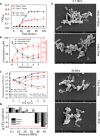Oxidation of trimethylamine to trimethylamine N-oxide facilitates high hydrostatic pressure tolerance in a generalist bacterial lineage
- PMID: 33771875
- PMCID: PMC7997507
- DOI: 10.1126/sciadv.abf9941
Oxidation of trimethylamine to trimethylamine N-oxide facilitates high hydrostatic pressure tolerance in a generalist bacterial lineage
Abstract
High hydrostatic pressure (HHP) is a characteristic environmental factor of the deep ocean. However, it remains unclear how piezotolerant bacteria adapt to HHP. Here, we identify a two-step metabolic pathway to cope with HHP stress in a piezotolerant bacterium. Myroides profundi D25T, obtained from a deep-sea sediment, can take up trimethylamine (TMA) through a previously unidentified TMA transporter, TmaT, and oxidize intracellular TMA into trimethylamine N-oxide (TMAO) by a TMA monooxygenase, MpTmm. The produced TMAO is accumulated in the cell, functioning as a piezolyte, improving both growth and survival at HHP. The function of the TmaT-MpTmm pathway was further confirmed by introducing it into Escherichia coli and Bacillus subtilis Encoded TmaT-like and MpTmm-like sequences extensively exist in marine metagenomes, and other marine Bacteroidetes bacteria containing genes encoding TmaT-like and MpTmm-like proteins also have improved HHP tolerance in the presence of TMA, implying the universality of this HHP tolerance strategy in marine Bacteroidetes.
Copyright © 2021 The Authors, some rights reserved; exclusive licensee American Association for the Advancement of Science. No claim to original U.S. Government Works. Distributed under a Creative Commons Attribution NonCommercial License 4.0 (CC BY-NC).
Figures






Similar articles
-
Structural basis of a microbial trimethylamine transporter.mBio. 2025 Jan 8;16(1):e0191424. doi: 10.1128/mbio.01914-24. Epub 2024 Nov 22. mBio. 2025. PMID: 39576113 Free PMC article.
-
High Hydrostatic Pressure Inducible Trimethylamine N-Oxide Reductase Improves the Pressure Tolerance of Piezosensitive Bacteria Vibrio fluvialis.Front Microbiol. 2018 Jan 9;8:2646. doi: 10.3389/fmicb.2017.02646. eCollection 2017. Front Microbiol. 2018. PMID: 29375513 Free PMC article.
-
Structural mechanism for bacterial oxidation of oceanic trimethylamine into trimethylamine N-oxide.Mol Microbiol. 2017 Mar;103(6):992-1003. doi: 10.1111/mmi.13605. Epub 2017 Jan 10. Mol Microbiol. 2017. PMID: 27997715
-
Trimethylamine N-Oxide, the Microbiome, and Heart and Kidney Disease.Annu Rev Nutr. 2017 Aug 21;37:157-181. doi: 10.1146/annurev-nutr-071816-064732. Epub 2017 Jul 17. Annu Rev Nutr. 2017. PMID: 28715991 Review.
-
Co-evolution of proteins and solutions: protein adaptation versus cytoprotective micromolecules and their roles in marine organisms.J Exp Biol. 2015 Jun;218(Pt 12):1880-96. doi: 10.1242/jeb.114355. J Exp Biol. 2015. PMID: 26085665 Review.
Cited by
-
A moderately thermophilic origin of a novel family of marine group II euryarchaeota from deep ocean.iScience. 2023 Aug 17;26(9):107664. doi: 10.1016/j.isci.2023.107664. eCollection 2023 Sep 15. iScience. 2023. PMID: 37680465 Free PMC article.
-
High Hydrostatic Pressure in the Modulation of Enzymatic and Organocatalysis and Life under Pressure: A Review.Molecules. 2023 May 18;28(10):4172. doi: 10.3390/molecules28104172. Molecules. 2023. PMID: 37241913 Free PMC article. Review.
-
Structural basis of a microbial trimethylamine transporter.mBio. 2025 Jan 8;16(1):e0191424. doi: 10.1128/mbio.01914-24. Epub 2024 Nov 22. mBio. 2025. PMID: 39576113 Free PMC article.
-
Comparison of prokaryotes between Mount Everest and the Mariana Trench.Microbiome. 2022 Dec 7;10(1):215. doi: 10.1186/s40168-022-01403-y. Microbiome. 2022. PMID: 36476562 Free PMC article.
-
Bacterial killing and the dimensions of bacterial death.NPJ Biofilms Microbiomes. 2024 Sep 17;10(1):87. doi: 10.1038/s41522-024-00559-9. NPJ Biofilms Microbiomes. 2024. PMID: 39289404 Free PMC article.
References
-
- Lundsten L., Schlining K. L., Frasier K., Johnson S. B., Kuhnz L. A., Harvey J. B. J., Clague G., Vrijenhoek R. C., Time-series analysis of six whale-fall communities in Monterey Canyon, California, USA. Deep Sea Res. Part I Oceanogr. Res. Papers 57, 1573–1584 (2010).
-
- Newell C. R., Pilskaln C. H., Robinson S. M., MacDonald B. A., The contribution of marine snow to the particle food supply of the benthic suspension feeder, Mytilus edulis. J. Exp. Mar. Biol. Ecol. 321, 109–124 (2005).
-
- Oger P. M., Jebbar M., The many ways of coping with pressure. Res. Microbiol. 161, 799–809 (2010). - PubMed
-
- Jebbar M., Franzetti B., Girard E., Oger P., Microbial diversity and adaptation to high hydrostatic pressure in deep-sea hydrothermal vents prokaryotes. Extremophiles 19, 721–740 (2015). - PubMed
Publication types
MeSH terms
Substances
LinkOut - more resources
Full Text Sources
Other Literature Sources
Molecular Biology Databases

